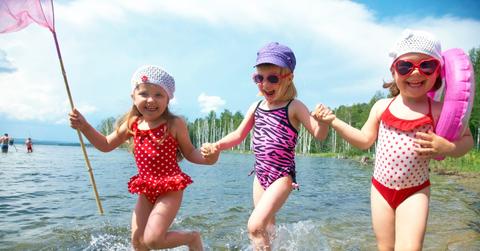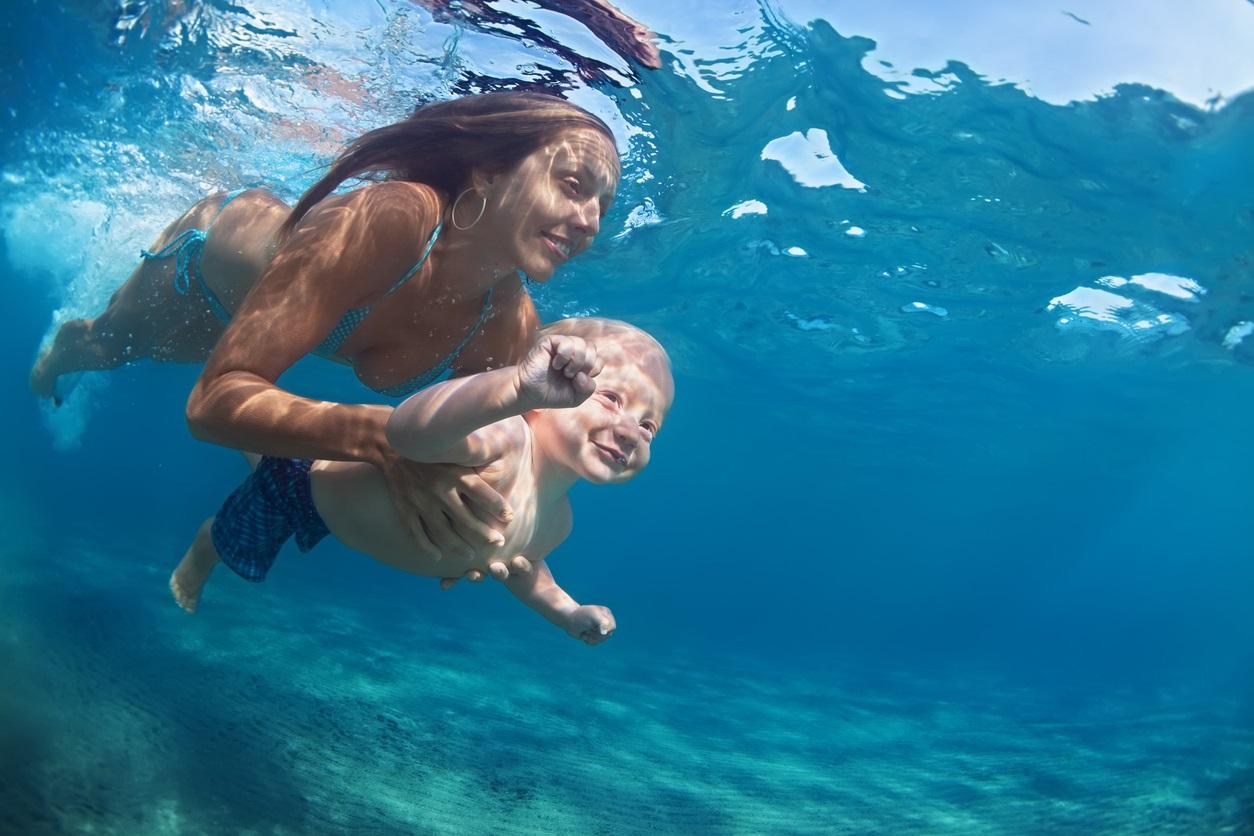Water Safety Lessons Every Family Needs For Summer Vacations
As the weather warms up, families take to the water. Swimming is an important skill for kids to learn, but a trip to the water carries risks. Brushing up on water safety, sun safety, and the signs of drowning can help keep your family safe.
Updated Nov. 19 2020, 9:39 p.m. ET
As the weather warms up, families take to the water for summer adventures. Swimming is an important skill for kids to learn, but a trip to the pool, local lake, or beach still carries some risks. Here are some things to consider in order to plan a truly safe swimming experience with your family, ranging from how to tell if water is safe to dip into, sun safety, what to wear at the beach, and the under-discussed signs of drowning every parent needs to know.
Brush up on pool safety ahead of time.
Public pools, lakes, ponds, rivers, and oceans. There are many different places where families can go to swim, and each comes with its own risks and benefits.
For example, public pools are some of the most widely available swimming spots for families--almost every town, no matter how small, has a pool somewhere, either at the local park, health center, or YMCA. Most are required to have lifeguards on duty, which adds safety. But public pools can also pose several health risks. Because small children have a bad habit of alleviating themselves in pool water from time to time, public pools often fill their water with harsh chemicals.
Chlorine, cyanuric acid and bromine are just a few of the substances commonly put into pool water to "sanitize" it. These chemicals can cause skin irritation such as itchiness, dryness, redness or even hives. They can also irritate sinuses; something that is especially important to keep in mind if your child is asthmatic or has other breathing issues.
Know the signs of clean water.
Small ponds and large lakes can be great places to swim, as long as public swimming is allowed in certain areas. If the pond or lake is part of a public park, there should be signs marking areas that are safe to swim, and some outdoor swimming areas even have lifeguards on duty. Lakes and ponds have no chemicals to deal with and swimming in these areas can help your children connect with nature. However, not all natural water is healthy.
Bacteria and parasites can be present in pond and lake water, so it is important to recognize when a body of water is clean, and teach kids not to swallow the water. Avoid ponds and lakes with an abundance of algea or scum sitting on top of the water, as this encourages mosquitoes and is a sign that the water may be polluted. When deciding whether to swim in a pond or lake, be sure that you can see the bottom through at least two feet of water. Also be sure to check the water's temperature. Warm ponds and lakes are more likely to harbor bacteria.
Rivers can be fun places to wade and swim. River currents mean that their waters tend not to stagnate as much as ponds or lakes, so their water has a higher chance of being bacteria free. But river currents can make this an unwise choice for very small swimmers. Even in areas where the current is relatively slow, small children can be pushed against rocks and end up with bruises and cuts. Unless your child has had swimming lessons, don't allow them to swim alone in a river. If they stay close by an adult at all times, wear a life jacket and use a flotation device, such as an inner tube, the chance of injury can be greatly reduced.
If you're lucky enough to live near a beach, the ocean may be your family's swimming spot of choice. Many beaches keep life guards on duty, so it may be wise to choose a supervised beach if you have small children. Saltwater can sometimes irritate skin, but usually will not irritate sinuses the way that pool chemicals do. And saltwater carries far less bacteria than still bodies of freshwater. Just make sure to review the most basic rule of ocean safety with kids before allowing them in the water: never swim more than a few feet from shore without an adult.
Use healthy sun protection.
While the sun can provide us with nice tans and lots of Vitamin D, it can also burn us and increase our risk of skin cancer, if we aren't careful. When swimming outdoors, it's important to use sun protection. But traditional sunscreens are often packed with harsh chemicals and other potentially harmful ingredients. Luckily there are companies that produce sunscreen with all-natural ingredients. You can also make your own sunscreen using an online recipe, and opt for sun-protective clothing such as board shorts, cover-ups and sun hats. For more ideas on how to keep your family safe from the sun in a healthy way, check out this list.
Wear appropriate swimwear.
Most adults know that it's important for kids to wear life vests unless closely supervised by an adult. Water wings and other wearable safety equipment can help keep children afloat. But even the type of regular clothing we wear into the water can have a great impact on our safety. In still bodies of water, heavy shoes or dense fabrics can become soaked with water, pulling us down and making it more difficult to swim. In moving bodies of water, loose clothing, such as t-shirts and baggy pants, can become tangled on floating debris. When swimming underwater, getting caught against a rock or log can quickly turn into a life-threatening situation.
Luckily these scenarios can be easily avoided. When venturing into the water, be sure that your family's clothing is lightweight and lays close to the skin. The bottoms of ponds, lakes and rivers tend to be rocky, so secure footwear should always be worn. Specially designed wading and water shoes can be found at any sports supply store, and are usually fairly inexpensive.
Know how to recognize the signs of drowning.
Most people believe that they know what drowning looks like. Almost every adult has seen some depiction of drowning on T.V. or in a movie. The problem is, drowning often doesn't look anything like its fictional portrayals. Stories abound of people whose friends or even children were drowning only a few feet away, while they didn't even realize. That's because in real life, drowning is often a quiet process, wherein the victim is often unable to make any noise at all.
So what are some real signs of drowning to watch out for? Look for someone who can't call for help. Simply asking someone, "How are you doing?" or "Do you need help?" can be good indicators, as they likely can't respond if they're drowning or in danger of drowning. They will likely be unable to wave. If they are moving, they may be struggling in a particular direction, without making any headway. Be on the lookout for anyone whose mouth is at water level, with their face obstructed by hair, or whose head is tilted back as they gasp for breath. Their eyes may have a glossy or unfocused appearance due to lack of oxygen.
The importance of flotation aids for small children, especially life vests, can't be overstated. In many natural bodies of water, it's required that everyone, children and adults, wear life vests at all times. It's also not a bad idea to have you or your family become first-aid certified or take specific swim-safety lessons before embarking on a summer vacation.
Swimming will always carry some risks, no matter what your age. But following the few steps listed above will help your family have a summer swim that is truly as safe as it can possibly be.

